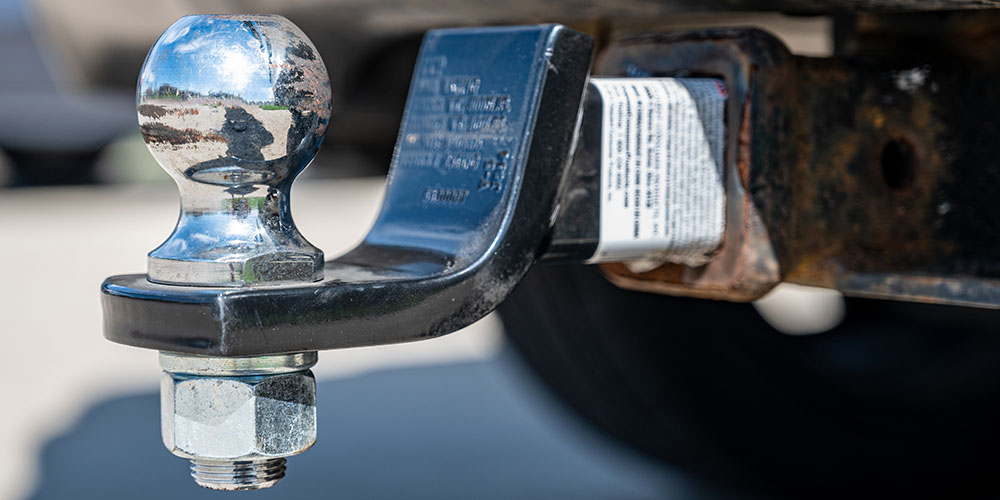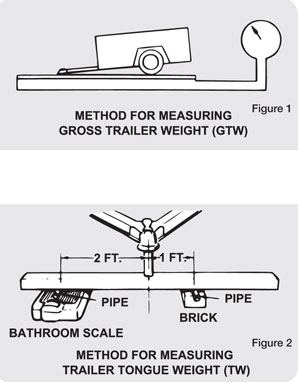

Use the Right Hitch Ball
Always use the properly rated hitch ball for your towing system.
Your towing system’s maximum weight rating is always equal to the lowest rated item in the system.
Your hitching system cannot be upgraded to a rating higher than the maximum rating of your hitch. For example, a 3,500lb. ball on a 2,000lb. maximum trailer weight-rated hitch does not increase your towing capacity to 3,500lb. Your hitching system is still rated at 2,000lb. Conversely, a 2,000lb. ball on a 3,500lb. maximum trailer weight-rated hitch decreases your maximum towing capacity to 2,000lb.
The hitch ball diameter: (A) must be the same diameter as the trailer coupler (1-7/8", 2", or 2-5/16") because a ball that is undersized will allow the trailer to bounce loose.
The shank diameter: (B) of the hitch ball should be the same as the hole diameter in the (correct) ball mount you selected.
The shank length: (C) should be long enough to allow at least two threads to be visible when the hitch ball is installed and the nut completely tightened.
Check the Weight Rating of Your Hitch
Make sure your hitch is rated correctly for the trailer you tow:
| Class | Maximum Trailer Weight* | Tongue Weight Limit | Receiver Tube Dia. | Vehicle Attachments |
|---|---|---|---|---|
| I | 2,000lb. | 200lb. | 1-1/4" | Bumper and 2 points on frame |
| II | 3,500lb. | 350lb. | 1-1/4" | At least 2 points on frame |
| III | 8,000lb. | 800lb. | 2" | At least 4 points on frame |
| IV | 10,000lb. | 1,200lb. | 2-1/2" | At least 4 points on frame |
| V | 12,000lb. | 1,400lb. | 2-1/2" | At least 4 points on frame |
| *Includes weight of trailer, boat and gear. | ||||
Select a Ball Mount With the Right Rise or Drop
Leveling your trailer: Your trailer needs to be level fore and aft so the weight is distributed properly and the trailer handles the way it should, but the trailer hitch receiver on your particular tow vehicle is unlikely to be at the same height as the trailer tongue. To level your towing rig, we sell ball mounts made with different amounts of “drop” which is the distance from the top of the shank to the top of the ball platform which lowers the actual towing ball the amount needed (between 3/4" and 8"). Most are reversible; turn the ball mount upside down to add “rise” if your trailer is higher than the car’s receiver.

How Much Is Your Trailer’s Tongue Weight?
Why it’s important: A trailer with improperly balanced weight may “fishtail,” swaying from side to side as it moves down the highway, creating excessive loads on both tow vehicle and trailer, increasing gas consumption or even causing an accident. Guard against fishtailing by making sure the weight load of your trailer is properly distributed. The weight on your trailer’s hitch ball (when the trailer tongue is parallel to the ground) should equal 7 to 12 percent of the weight of the loaded trailer.
Check the information supplied by the trailer manufacturer to see if there is a specific percentage for your particular model. For example, if the gross weight of trailer, boat and gear is 1,500 pounds, the weight on the tongue should not be more than 180 pounds, nor less than 105 pounds. (Some auto manufacturers say that tongue weight should not exceed 200 pounds when using a weight-carrying hitch with full-size cars).

Measuring Tongue Weight
Tongue Weight (TW) of up to 300 pounds can be measured on a household scale by resting the trailer coupler on the scale and placing the scale on a box so that the coupler is at its normal towing height. The trailer must be fully loaded and level.
For heavier tongue weights, place a household scale and a brick that’s as thick as the scale three feet apart as shown in Figure 2.
Set a length of pipe on each and rest a beam across the pipes. Re-zero the scale to correct for the weight of the beam and pipe. Securely block the trailer wheels. Rest the trailer jack on the beam as shown, one foot from the brick and two feet from the scale.
To obtain the TW, multiply the scale reading by three. For greater tongue weights, place the scale and brick four feet apart, rest the jack on the beam three feet from the scale and multiply the scale reading by four.
Weighing Your Trailer
Gross trailer weight (GTW) is the weight of the trailer fully loaded in its actual towing condition. GTW is measured by placing the fully loaded trailer on a vehicle scale. The entire weight of the trailer should be supported on the scale as shown in Figure 1.

Connect Your Safety Chains Correctly
Connect the safety chains correctly, by criss-crossing them below the trailer tongue, so they will support the front of the trailer above the roadbed if it disconnects. The S-hooks should be attached to the tow vehicle's trailer hitch receiver with the open end of the hook facing up, so they will not bounce off.
Is your tow vehicle up to the job?
Make sure your tow vehicle is big and powerful enough for the boat, trailer and gear it needs to pull. While one of our friends tows his Ultimate 20 sailboat (weighing 1800lb. combined with its trailer) using a puny Toyota Matrix—that’s a bad idea. Be realistic, and don’t let the tail wag the dog.
A Chevy Suburban, Ford Econoline van, pickup truck or similar vehicle is a good choice for the 21' to 24' boat. A full-size body-on-frame, rear-wheel-drive car is generally better than a small front-wheel-drive unibody auto like the above-mentioned Matrix for towing smaller trailers. Trying to tow with an undersized vehicle is dangerous, and likely to lead to overheating and drivetrain or brake failure. Each tow vehicle has a maximum rated trailer weight, which may be provided in the owner’s manual.
Hitch and Coupler Glossary
Other Articles on Trailering
Ball Height: Measurement from the ground to the center of the hitch ball or hitch ball coupling (trailer) when parked on a flat surface and parallel to the ground. Used to determine the amount of drop or rise needed in the ball mount to make the trailer ride parallel to the ground when being towed. The maximum recommended hitch ball height for trailers is 25" from the ground measured to the center of the hitch ball.
Ball Mount: Also called a Drawbar or Hitch Bar. Removable hitch ball platform that slides into the receiver tube and fastens with a pin and clip. Ball mounts can be used to raise or lower the height of the ball to adjust for level trailer towing.
GAW|Gross Axle Weight: The total weight supported by each of the vehicle’s axles (front or rear).
GAWR|Gross Axle Weight Rating: The manufacturer’s rating of the maximum allowable weight an axle is designed to carry. GAWR applies to tow vehicle or trailer axles.
GCW or GCVW|Gross Combined (Vehicle) Weight: Actual total combined weight of a vehicle and trailer, including all passengers and payload.
GCWR|Gross Combination Weight Rating: Maximum allowable weight of the combination of tow vehicle and trailer/fifth-wheel, or motorhome and dinghy. It includes the weight of the vehicle, trailer/fifth-wheel (or dinghy), cargo, passengers and a full load of fluids (fresh water, propane, fuel, etc.)
GTW|Gross Trailer Weight: Total weight of the full-loaded trailer in its actual towing condition.
GVW|Gross Vehicle Weight: The total weight of a fully loaded vehicle, including all of its contents and passengers.
GVWR|Gross Vehicle Weight Rating: The total weight of a vehicle, specified as the recommended weight when fully loaded by the manufacturer, including passengers, cargo, and fluids.
Hitch: Attaches directly to a tow vehicle providing the connection between the tow vehicle and the trailer. Hitch installations are usually permanent. A fixed-tongue hitch includes a flat, non-removable drawbar. A receiver-style hitch has a receptacle (usually 1 1/4" or 2" square) for inserting ball mounts or accessories like a receiver cover.
Hitch Ball: Ball-shaped attachment to a hitch onto which a trailer coupler is attached. The coupler mounts and locks on top of the hitch ball and articulates around the hitch ball. Recreational and light commercial hitch balls come in a variety of sizes including 1 7/8", 2", 2 5/16" and infrequently, 3". Lighter trailers generally use smaller hitch balls. The diameter of hitch balls is fairly standard, but shank diameters and the hitch ball weight ratings may differ. The rating of the hitch ball is just as important as the receiver hitch rating.
Plug: The electrical fitting used to connect trailer wiring to a tow vehicle. The name “Plug” refers to the trailer end of the connection. “Socket” refers to the car end.
Powered Converter (Tail Lamp): Converts three-wire tow vehicle electrical systems to two-wire systems, integrating the stop and turn signal circuits as is typical in trailer wiring. This converter is powered by the vehicle battery, allowing the trailer lights to be illuminated with virtually no draw on the vehicle taillight circuit. Powered converters are recommended on most vehicles with LED taillights.
Receiver Tube: Receptacle part of a trailer hitch, which accommodates inserts such as ball mounts, drawbars or accessory carriers. Common receiver sizes are 1 1/4" and 2" square.
Shank: Part of the insert that slides into the receiver hitch.
Tongue Weight (TW): Downward force exerted on the trailer ball by the coupler. Tongue weight varies depending on where the load is positioned in relation to the trailer axle(s).
Tow Rating: Manufacturer’s rating of the maximum weight limit that can be safely towed by a particular vehicle. The tow rating depends on overall trailer weight, not trailer size, in most cases. However, some tow ratings impose limits as to frontal area of the trailer and overall length. Tow ratings are set by the vehicle manufacturer using several criteria, including engine size, transmission, axle ratio, brakes, chassis, cooling systems and other special equipment.
Transmission Cooler: An auxiliary cooler that is available to provide extra cooling for automatic transmission fluid. Lower temperatures equal longer transmission life.
Weight Carrying (WC) Hitch: Any hitch without a weight-distributing system. Some hitches are designed and clearly marked "weight carrying only". Some hitches are weight carrying with weight distributing ability and will have a dual rating – "weight carrying (WC) 5000 / weight distributing (WD) 10,000," for example. To use a hitch at the higher rating (WD), a weight distribution system must be added.
Weight Distribution Hitch: A hitch system built around a receiver hitch that includes supplemental equipment such as spring bars that can be placed under tension to distribute trailer tongue loads to the trailer axle(s) and the tow vehicle front axle. Use of weight distribution system enhances handling and braking and increases trailer towing capacity. Weight distributing hitches currently come in two configurations: one with square bars that hook to the center of the ball mount, called trunnion bars; and one with round bars that slide into the bottom of the ball mount, called round bars.